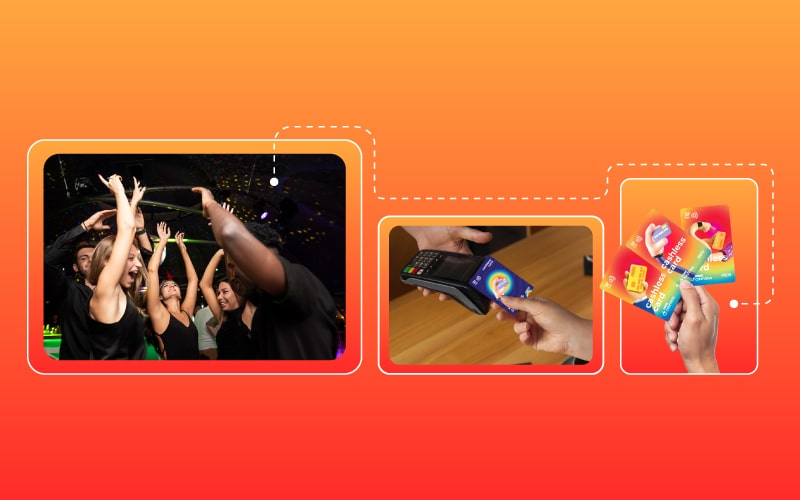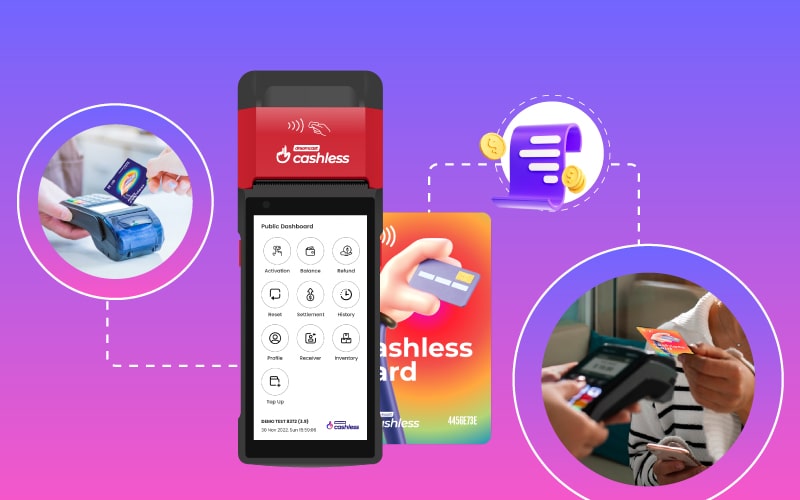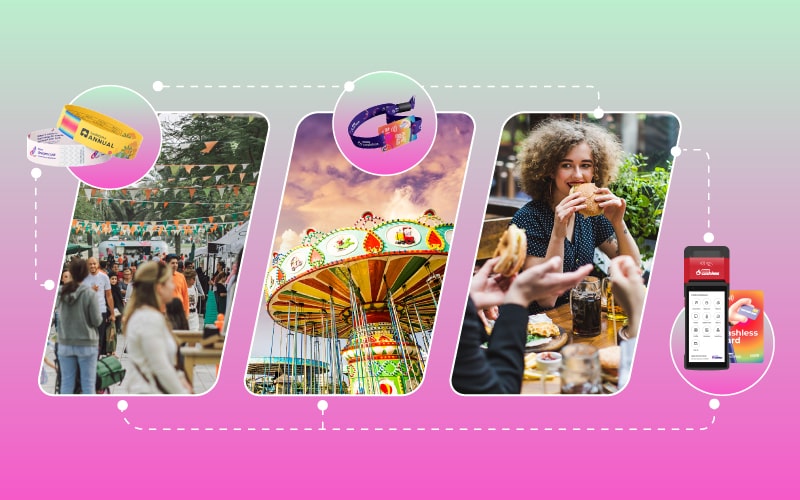In the ever-evolving world of theme parks, the adoption of cashless payment systems has become increasingly widely accepted. Cashless cards transform the way guests experience these amusement and entertainment destinations.
From RFID wristbands to contactless cards, cashless payments offer convenience, security, and enhanced guest satisfaction. In this comprehensive guide, we’ll explore the various payment systems used in theme parks, their benefits, implementation, and impact on the overall guest experience.
Evolution of Cashless Payment Systems in Theme Park

Theme parks relied on cash transactions for ticket sales, food purchases, and shopping. With the advancement of technology and consumer preferences shifting towards digital transactions, theme park operators recognized the need to embrace cashless payment solutions. The evolution of cashless systems in theme parks can be traced through several key innovations:
Introduction of RFID Wristbands: Theme parks began implementing RFID (Radio Frequency Identification) wristbands that guests could preload with funds and use for various transactions throughout the park. RFID technology allows seamless and contactless payments, reducing wait times and enhancing convenience.
Integration with Mobile Apps: To further enhance the guest experience, theme parks developed a dedicated mobile app. The app can enable guests to link their payment methods, view ride wait times, make dining reservations, and purchase tickets directly from their smartphones. Mobile apps became a central hub for cashless transactions and park information.
Acceptance of Contactless Payment Cards: With the popularity of contactless payments, theme parks started accepting RFID contactless cards. This allows guests to tap their cards on payment terminals for quick and secure transactions.
Benefits of Cashless Payment Systems for Theme Parks

The adoption of cashless payment systems can bring numerous benefits for both theme park guests and operators:
Convenience and Efficiency: Cashless systems streamline transactions, reducing wait times at ticket booths, food kiosks, and merchandise shops. Guests can make payments quickly and efficiently, enhancing their overall park experience.
Enhanced Guest Satisfaction: Cashless payment systems offer guests greater convenience and flexibility. They no longer need to carry cash or worry about losing wallets in crowded environments. Cashless systems contribute to a more seamless experience and enjoyable park visit.
Improved Operational Efficiency: By reducing reliance on cash handling, theme parks can streamline operations and allocate resources more effectively. Cashless systems minimize errors, simplify reconciliation processes, and enhance overall operational efficiency.
Enhanced Security and Safety: Cashless transactions reduce the risk of theft and loss associated with carrying cash. Advanced encryption and tokenization technologies protect guest payment information, ensuring secure transactions throughout the park.
Data–driven Insights: Cashless payment systems generate valuable data insights that enable theme park operators to analyze guest spending patterns, track inventory levels, and optimize revenue management strategies. This data-driven approach facilitates informed decision-making and targeted marketing efforts.
Implementation of Cashless Payment Systems At Theme Parks

Implementing cashless payment systems in theme parks involves several key steps:
1. Infrastructure Setup
Network Connectivity:
– Ensure robust and reliable network connectivity throughout the theme parks to support cashless transactions.
– This involves deploying other event networking solutions depending on the venue.
Deployment of Payment Terminals:
– Installing sufficient payment terminals at various locations within the theme parks, including entry gates, food stalls, beverage vendors, merchandise booths, and other points of sale.
– Terminals should support a variety of payment methods, including RFID wristbands, mobile apps, and contactless cards.
2. Wristband Distribution and Registration
Wristband Distribution:
– Provide attendees with RFID wristbands upon entry to the grounds.
– Wristbands should be durable, waterproof, and equipped with RFID technology for contactless payments.
Registration Process:
– Offer attendees the option to register their wristbands online before the theme park or at designated registration kiosks onsite.
– Registration typically involves linking the wristband to the attendee’s payment method and creating a user account for transaction tracking and management.
3. Guest Education and Support
Onsite Assistance:
– Train theme park staff to provide clear instructions and assistance to attendees regarding the use of cashless payment systems.
– Set up information booths or help desks where attendees can receive guidance and troubleshoot any issues they encounter.
Communication:
– Utilize different communication channels to educate attendees about the benefits and features of cashless payment systems.
– Provide information through the theme park website, and social media channels to ensure attendees are informed prior to arrival.

4. Monitoring and Optimization
Real-time Monitoring:
– Use analytics and reporting tools to monitor cashless transactions in real time.
– Track spending patterns, identify popular vendors, and assess overall transaction volume to inform operational decisions.
Feedback Collection:
– Solicit feedback from attendees regarding their experience with cashless payment systems.
– Gather insights on usability, reliability, and areas for improvement to inform future implementation efforts.
5. Evaluation and Iteration
Post-event Evaluation:
– Conduct a comprehensive review of the cashless payment system implementation post-event.
– Evaluate key performance metrics such as transaction volume, guest satisfaction, and operational efficiency.
Continuous Improvement:
– Identify areas of success and areas for improvement based on post-event evaluation.
– Use feedback and data insights to refine the implementation process and enhance the cashless payment experience for future theme parks.
Learn more: 8 Reasons to Choose Cashless Payment for Music Events and Festival
Tips for Guests Using RFID Cashless Payment Cards in Theme Parks

If you’re planning to visit a theme park that uses RFID cashless payment cards, here are some tips to help you make the most of the system and have a smooth experience:
Obtain Your RFID Cashless Payment Card:
Upon entering the theme park, you will typically receive an RFID cashless payment card. Make sure to collect it and keep it in a safe place, such as a wallet or lanyard.
Load Funds:
Load sufficient funds onto your card before starting your park activities. This can usually be done at designated kiosks or through the park’s mobile app.
Understand How to Use the RFID Card:
Familiarize yourself with the process of using the RFID cashless payment card. Typically, you will need to tap or scan the card at designated payment terminals located at food stalls, merchandise shops, and other points of sale.
Secure Your RFID Card:
Treat your RFID cashless payment card like cash. Keep it in a secure place, and avoid losing or damaging it. Some parks may charge a fee for card replacements, so it’s important to take care of your card throughout your visit.
Check Balances Regularly:
Stay aware of your remaining balance on the RFID card. Check the balance regularly to manage your spending and avoid running out of funds unexpectedly.
Plan Your Budget:
Determine your budget for the day and allocate funds accordingly on your RFID card. This will help you control your spending and ensure that you have enough funds for the activities and purchases you plan to make.
Keep Track of Transactions:
Keeping track of your transactions helps to maintain a mental note of your purchases. It further helps you reconcile your expenses and identify unauthorized charges.
Final Words
Cashless payment systems have been revolutionizing theme parks by offering guests a secure payment experience while enhancing operational efficiency for park operators.
From RFID wristbands to contactless cards, the diverse range of cashless payment options available for theme parks reflects a commitment to innovation and guest satisfaction. By leveraging cashless payment systems by Dreamcast, theme parks can embrace future trends and make immersive experiences in the digital age.
FAQs
Cashless payment systems benefit visitors by offering faster transactions, reduced need to carry cash or cards, enhanced security against theft or loss, and access to features like mobile app integration for ride reservations and food ordering.
Cashless payment systems improve park operations by reducing cash handling, minimizing errors, optimizing inventory management based on transaction data, and enhancing revenue management through data-driven insights.
Yes, cashless payment systems in theme parks employ robust security measures such as encryption, tokenization, and fraud detection to protect guest information and transactions. These systems comply with industry standards and data protection regulations.
Guests can track their spending in real time through associated mobile apps or online accounts. This transparency allows guests to manage their budgets, review transaction history, and make informed decisions about their purchases.
Yes, cashless payment systems significantly reduce wait times at attractions, food outlets, and stalls by making payments faster. Guests spend less time handling cash or waiting for change, leading to a seamless and more enjoyable experience.






